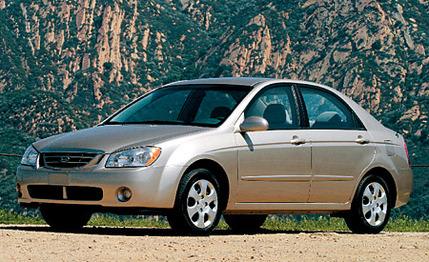
 First Drive Review
First Drive Review
"We think it'll go head-to-head with today's top small cars," said Peter Butterfield, president and CEO of Kia Motors America, referring to his brand's all-new Spectra compact sedan.
We wondered if Butterfield had been listening to Kid Rock, Mr. Cocky himself, earlier that day. It was conceivable. But as the Kid would say, "It ain't braggin' . . . if you back it up."
Those of us in the press seats shuffled uneasily in our chairs, as if we were watching some pro jock guarantee victory after his team had just dropped 10 straight.
You sure about that, Mr. Butterfield?
After all, the current Spectra is not the greatest of building blocks. In our last economy-sedan comparison test ("Double-Dip Dreamboats," November 2002), it finished in the cellar among nine competitors. This would have to be one helluva turnaround.
To spur that 180-degree reversal, Kia changed, well, the whole dang car. Or as Kia's chief press wrangler, Kim Custer, said, "We changed everything but the name." That's one way to do it.
For the foundation, Kia turned to parent Hyundai and borrowed the robust Elantra platform-underpinning for the upcoming Hyundai Tucson small SUV-to which it bolted a four-wheel independent suspension with MacPherson struts up front, a multilink and strut setup in the rear, and anti-roll bars at each end. Compared with its predecessor, the new car is wider by nearly an inch and taller by over two inches, and it features a wider track and a wheelbase two inches longer. The steering system is a rack-and-pinion arrangement with power assist that is sensitive to engine speed. The brakes are discs at all four corners, available with ABS and electronic brake-force distribution on the high-line trim. The wheels measure 15 inches in diameter and wear 195/65R-15 rubber.
To motivate its bestselling nameplate, Kia screwed together a new 2.0-liter four-cylinder engine with variable valve timing-a first for a Kia car-that serves up 138 horsepower and 136 pound-feet of torque (132 horsepower and 133 pound-feet in Super Ultra Low-Emission Vehicle form), which amounts to increases of 14 horsepower and 17 pound-feet, all of which is delivered to the front wheels via a standard five-speed manual or an optional four-speed automatic.
Inside, the Spectra comes standard with front, side, and curtain airbags-the lowest-priced car in America to offer all of these at no extra cost. The seatbelts up front feature pretensioners and force limiters, and all three rear seatbelts secure passengers over the shoulder. Rounding out the long list of standard features are an adjustable steering wheel, a CD stereo with six speakers, a 60/40 split-folding rear seat, and variable intermittent wipers. All of these niceties complement an interior that offers 97 cubic feet of passenger space-more than any of its competitors, and even outdoing some upscale Euros, such as the Volvo S60 and the Audi A4.
Speaking of the A4, the Spectra appears to have knocked off the Audi's hind end, wearing similar wedgelike taillights and a sloping trunklid. You could also argue that the Spectra knocked off the Audi's quality standards; the new car's panel gaps are minute. Its doors close with a comforting thud, and its interior fit and finish is premium. This is not your cousin's friend's Kia.
Of course, all this goodness means squat if the new Spectra drives like the old one. It doesn't. Far from it. On the highway, the cabin is a place of Lexus-like serenity. The ride is smooth yet never feels like the dampers have been swapped for wet sponges. The loosey-goosey steering sense is gone, replaced with an effort and feel that, although perhaps too light, clearly relays the front tires' attitude. And the brakes offer up a firm pedal feel and reassuring performance. A switchback sign is now an invitation, not a warning.
Accelerating to 60 seems to come a tick sooner than the old car's 9.2-second time, thanks to the 2.0-liter's additional ponies and fatter torque curve. Moreover, the 2.0-liter delivers new levels of refinement for a Kia four-banger, never becoming too rough or raucous as did the old 1.8. The standard five-speed manual gets the job done, but it still brings that "which gear am I in?" negotiation that's reminiscent of stirring a wooden spoon in a bowl of Jell-O. Gee, I hope that was a five-four downshift and not a five-two. The clutch feel could be better, too. As it is, engagement is ambiguous, often making throttle transitions abrupt. The optional automatic is a smooth operator, but it saps too much of that 138 horsepower for our tastes. Other nits: The front seats lack lumbar support, and the ride could be a step or two firmer.
The good news is that our nits may be addressed with the Spectra5, a five-door hatchback version that will be out about the time you read this. The 5 comes standard with a sport suspension-16-inch wheels with 205/50R-16 tires, thicker anti-roll bars, and stiffer springs and dampers-a reworked five-speed, and more-supportive sport seats. Plus, it bumps cargo volume from the sedan's 12 cubic feet to 18.
Either way, the Spectra offers a lot for the money. Prices start at $13,160 for a four-door LX and $14,290 for an EX, which adds air conditioning; fog lights; and power windows, door locks, and mirrors, the latter heated. Kia hadn't announced pricing on the Spectra5, but we expect it to start at about $16,000.
So, Mr. Butterfield, go ahead and cook up some Kid Rock. Like him, you can back it up.